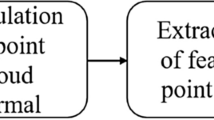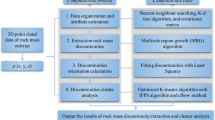Abstract
The staggered distribution of joints and fissures in space constitutes the weak part of any rock mass. The identification of rock mass structural planes and the extraction of characteristic parameters are the basis of rock-mass integrity evaluation, which is very important for analysis of slope stability. The laser scanning technique can be used to acquire the coordinate information pertaining to each point of the structural plane, but large amount of point cloud data, uneven density distribution, and noise point interference make the identification efficiency and accuracy of different types of structural planes limited by point cloud data analysis technology. A new point cloud identification and segmentation algorithm for rock mass structural surfaces is proposed. Based on the distribution states of the original point cloud in different neighborhoods in space, the point clouds are characterized by multi-dimensional eigenvalues and calculated by the robust randomized Hough transform (RRHT). The normal vector difference and the final eigenvalue are proposed for characteristic distinction, and the identification of rock mass structural surfaces is completed through regional growth, which strengthens the difference expression of point clouds. In addition, nearest Voxel downsampling is also introduced in the RRHT calculation, which further reduces the number of sources of neighborhood noises, thereby improving the accuracy and stability of the calculation. The advantages of the method have been verified by laboratory models. The results showed that the proposed method can better achieve the segmentation and statistics of structural planes with interfaces and sharp boundaries. The method works well in the identification of joints, fissures, and other structural planes on Mangshezhai slope in the Three Gorges Reservoir area, China. It can provide a stable and effective technique for the identification and segmentation of rock mass structural planes, which is beneficial in engineering practice.
Similar content being viewed by others
Availability of Data/Materials: The data that support the findings of this study are available from the first and corresponding author upon reasonable request.
References
Alliez P, Cohen-Steiner D, Tong Y, et al. (2007) Voronoi-based variational reconstruction of unoriented point sets. Proceedings of the fifth Eurographics symposium on Geometry processing 2007: 39–48. https://doi.org/10.1145/1281991.1281997
Barton N, Lien R, Lunde J (1974) Engineering classification of rock masses for the design of tunnel support. Rock Mech 6(4): 189–236. https://doi.org/10.1007/BF01239496
Boulch A, Marlet R (2012) Fast and robust normal estimation for point clouds with sharp features. Comput Graph Forum 31(5):1765–1774. https://doi.org/10.1111/j.1467-8659.2012.03181.x
Chen N, Cai XM, Xia JW, et al. (2021) Intelligent interpretation of rock mass discontinuity based on three-dimensional laser point cloud. Earth Sci 46(07):2351–2361. (In Chinese) https://doi.org/10.3799/dqkx.2020.282
Franklin JA, Maerz NH, Bennett CP (1988) Rock mass characterization using photoanalysis. Int J Min Geol Eng 6(2): 97–112. https://doi.org/10.1007/BF00880801
Ge YF, Xia D, Tang HM, et al. (2017) Intellectual identification and geometric properties extraction of rock discontinuities based on terrestrial laser scanning. J Rock Mech Geotech Eng 36(12): 3050–3061. (In Chinese) https://doi.org/10.13722/j.cnki.jrme.2017.0870
Gigli G, Casagli N (2011) Semi-automatic extraction of rock mass structural data from high resolution LiDAR point clouds. Int J Rock Mech Min Sci 48:187–198. https://doi.org/10.1016/j.ijrmms.2010.11.009
Guo DS, Xie MW, Liu WN, et al. (2022) Method and application of structural plane extraction of slope rock mass based on 3D point cloud. Min Res Dev 42(05):197–202. (In Chinese) https://doi.org/10.13827/j.cnki.kyyk.2022.05.003
Guo HS, Sun QC, Feng GL, et al. (2023) In-situ observations of damage-fracture evolution in surrounding rock upon unloading in 2400-m-deep tunnels. Int J Min Sci Technol 33(4):437–446. https://doi.org/10.3969/j.issn.2095-2686.2023.04.005
Hackel T, Wegner JD, Schindler K (2016) Contour detection in unstructured 3D point clouds.2016 IEEE Conference on Computer Vision and Pattern Recognition (CVPR2016), Las Vegas, NV, USA. pp 1610–1618. https://doi.org/10.1109/CVPR.2016.178
Hoppe H, DeRose T, Duchamp T, et al. (1992) Surface reconstruction from unorganized points. ACM Siggraph 71–78. https://doi.org/10.1145/142920.134011
Ji HW, Luo XQ, Zhou YJ, et al. (2020) Landslide data mosaicking based on an airborne laser point cloud and multi- beam sonar images. J Mt Sci 17(09):2068–2080. https://doi.org/10.1007/s11629-019-5896-7
Kang CL, Lan YL, Wang N, et al. (2022) A point cloud segmentation method for building roofs combining SIFT and 3D Hough Transform. Remote Sens Inf 37(05):31–37. (In Chinese)
Lato MJ, Voge M (2012) Automated mapping of rock discontinuities in 3D lidar and photogrammetry models. Int J Rock Mech Min Sci 54: 150–158. https://doi.org/10.1016/j.ijrmms.2012.06.003
Li B, Cheng ZQ, Dang G, et al. (2010) Survey on normal estimation for 3D point clouds. Comput Eng Appl 46(23):1–7. (In Chinese) https://doi.org/10.3778/j.issn.1002-8331.2010.23.001
Liu CJ, Ding LQ, Zhang FS, et al. (2014) Fuzzy cluster analysis of rock mass discontinuity of tunnel based on laser measurement and FKM clustering algorithm. J Jilin Univ (Earth Scie Ed) 44(01):285–294. (In Chinese) https://doi.org/10.13278/j.cnki.jjuese.201401206
Liu GF, Ran GH, Li ZQ, et al. (2023) An insight into the effect of primary hidden microfissures on mechanical behaviors and failure characteristics of brittle basalt. Theor Appl Fract Mec. https://doi.org/10.1016/j.tafmec.2023.104138
Li XJ, Chen ZY, Chen JQ, et al. (2019) Automatic characterization of rock mass discontinuities using 3D point clouds. Eng Geol 259: 105131. https://doi.org/10.1016/j.enggeo.2019.05.008
Li ZQ, Xue YG, Li SC, et al. (2017) Deformation features and failure mechanism of steep rock slope under the mining activities and rainfall. J Mt Sci 14: 31–45. https://doi.org/10.1007/s11629-015-3781-6
Moreira C, Francelino MR, Mendonça BAF, et al. (2020) Obtaining morphometric variables from gullies using two methods of interpolation laser scanner data: the case study of Vassouras, Brazil. J Mt Sci 17(12):3012–3023. https://doi.org/10.1007/s11629-020-6278-x
Pauly M, Keiser R, Kobbelt LP, et al. (2003) Shape modeling with point-sampled geometry. ACM Trans Graph 22(3):641–650. https://doi.org/10.1145/1201775.882319
Schnabel R, Wahl R, Klein R (2007) Efficient RANSAC for Point-Cloud shape detection. Comput Graph Forum 26:214–226. https://doi.org/10.1111/j.1467-8659.2007.01016.x
Slob S, Knapen BV, Hack R, et al. (2005) Method for automated discontinuity analysis of rock slopes with three-dimensional laser scanning. Transp Res Record 1913:187–194. https://doi.org/10.1177/0361198105191300118
Sturzenegger M, Stead D (2009) Close-range terrestrial digital photogrammetry and ter-restrial laser scanning for discontinuity characterization on rock cuts. Eng Geol 106:163–182. https://doi.org/10.1016/j.enggeo.2009.03.004
Tannant D (2015) Review of photogrammetry-based techniques for characterization and hazard assessment of rock faces. Int J Geohazard Environ 1(2):76–87. https://doi.org/10.15273/ijge.2015.02.009
Wang LY, Chen WZ, Tan XY, et al. (2019) Evaluation of mountain slope stability considering the impact of geological interfaces using discrete fractures model. J Mt Sci 16: 2184–2202. https://doi.org/10.1007/s11629-019-5527-3
Zhang P, Li JH, Yang X, et al. (2018) Semi-automatic extraction of rock discontinuities from point clouds using the ISODATA clustering algorithm and deviation from mean elevation. Int J Rock Mech Min Sci 110:76–87. https://doi.org/10.1016/j.ijrmms.2018.07.009
Acknowledgments
We are very grateful to the reviewers for their constructive revisions. This work is supported by the National Natural Science Foundation of China (51909136); the Open Research Fund of Key Laboratory of Geological Hazards on Three Gorges Reservoir Area(China Three Gorges University), Ministry of Education, Grant No. 2022KDZ21, and Fund of National Major Water Conservancy Project Construction (0001212022CC60001)
Author information
Authors and Affiliations
Contributions
XU Zhi-hua: data curation, methodology. GUO Ge: investigation, writing-original draft. SUN Qian- Cheng: methodology, writing-original draft, writing- review and editing. WANG Quan: data curation, Investigation. ZHANG Guo-dong: methodology, funding acquisition. YE Run-qing, writing-review and editing.
Corresponding author
Ethics declarations
Conflict of Interest: The authors declare no conflicts of interest.
Rights and permissions
About this article
Cite this article
Xu, Zh., Guo, G., Sun, Qc. et al. Structural plane recognition from three-dimensional laser scanning points using an improved region-growing algorithm based on the robust randomized Hough transform. J. Mt. Sci. 20, 3376–3391 (2023). https://doi.org/10.1007/s11629-023-7914-z
Received:
Revised:
Accepted:
Published:
Issue Date:
DOI: https://doi.org/10.1007/s11629-023-7914-z




